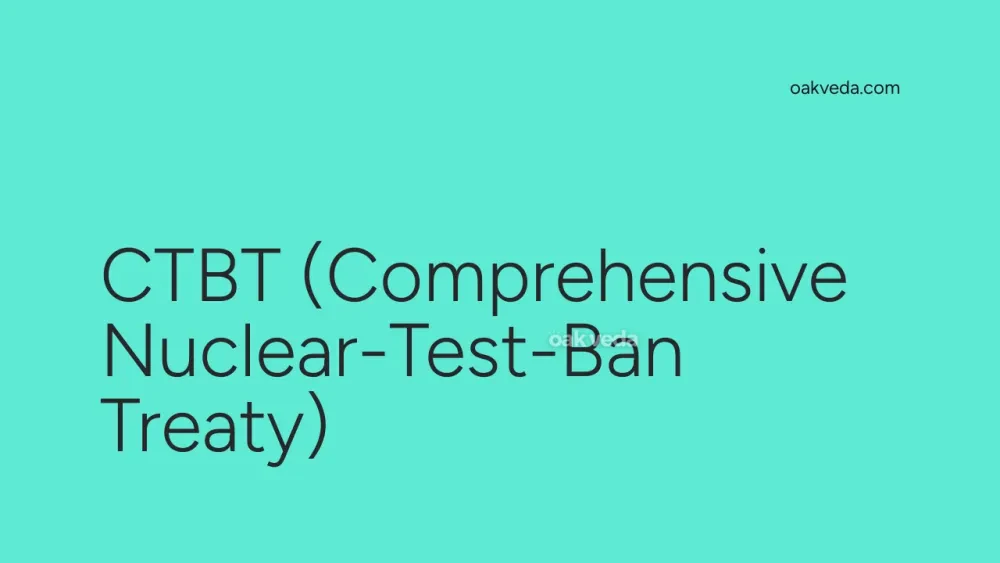
What is the Full Form of CTBT?
The full form of CTBT is the Comprehensive Nuclear-Test-Ban Treaty. This multilateral agreement is a crucial component of global efforts to prevent the proliferation of nuclear weapons and promote disarmament.
What is Comprehensive Nuclear-Test-Ban Treaty?
The Comprehensive Nuclear-Test-Ban Treaty is an international agreement that prohibits all nuclear explosions, whether for military or civilian purposes. It aims to create a world free from nuclear testing, thereby contributing to global peace and security.
Origin and Development of CTBT
The journey towards the CTBT began in the aftermath of World War II:
- 1945: The movement to control nuclear weapons started following the atomic bombings of Hiroshima and Nagasaki.
- 1963: The Partial Test Ban Treaty (PTBT) was signed, banning nuclear tests in the atmosphere, outer space, and underwater.
- 1994: Negotiations on a comprehensive ban began at the Conference on Disarmament (CD).
- September 10, 1996: The United Nations General Assembly adopted the CTBT with overwhelming support.
- September 24, 1996: The treaty was opened for signature.
As of 2023, 187 countries have signed the treaty, and 178 have ratified it. However, the treaty has not yet entered into force due to the non-ratification by some key states.
How does CTBT work?
The CTBT operates through a comprehensive verification regime:
-
International Monitoring System (IMS): A global network of 337 facilities using four technologies:
- Seismic
- Hydroacoustic
- Infrasound
- Radionuclide
-
International Data Centre (IDC): Processes and analyzes data from the IMS.
-
On-Site Inspections: Allows for on-site inspections to verify compliance.
-
Confidence-Building Measures: Promotes transparency among member states.
Functions of CTBT
The primary functions of the CTBT include:
- Prohibiting nuclear explosions worldwide
- Establishing a robust verification system
- Promoting nuclear disarmament and non-proliferation
- Encouraging peaceful uses of nuclear technology
Applications of CTBT
Beyond its primary purpose, the CTBT has several applications:
- Scientific research: Data from the IMS contributes to various scientific fields.
- Natural disaster monitoring: The monitoring system aids in earthquake detection and tsunami warnings.
- Climate change studies: Atmospheric data collected supports climate research.
- Environmental monitoring: Helps detect radioactive releases from nuclear accidents.
Features of CTBT
Key features of the CTBT include:
- Comprehensive ban on all nuclear explosions
- Global verification regime
- Equal participation of all member states
- Promotion of international cooperation
- Contribution to environmental protection
Benefits of CTBT
The CTBT offers numerous benefits:
- Enhances global security by curbing nuclear proliferation
- Prevents environmental damage from nuclear testing
- Promotes peaceful nuclear technology applications
- Strengthens international cooperation on security issues
- Contributes to scientific advancements through its monitoring system
Limitations or Challenges of CTBT
Despite its importance, the CTBT faces several challenges:
- Non-entry into force: The treaty requires ratification by all 44 Annex 2 states to become legally binding.
- Political obstacles: Some countries, like India, Pakistan, and North Korea, have not signed the treaty.
- Verification challenges: Ensuring complete detection of low-yield or decoupled tests.
- Maintaining the IMS: Ensuring long-term funding and technological updates.
Future Developments in CTBT Technology
The future of CTBT technology looks promising:
- Advanced detection methods: Improving sensitivity and accuracy of monitoring systems.
- AI and machine learning: Enhancing data analysis and pattern recognition.
- Satellite technology: Integrating space-based monitoring for comprehensive coverage.
- Open-source technologies: Incorporating civilian networks to complement the IMS.
FAQs on CTBT Full Form
-
What is the difference between signing and ratifying the CTBT? Signing indicates a country's intention to abide by the treaty, while ratification makes it legally binding.
-
Why hasn't the CTBT entered into force yet? It requires ratification by all 44 Annex 2 states, some of which have not yet done so.
-
How does the CTBT contribute to nuclear disarmament? By banning all nuclear explosions, it prevents the development of new nuclear weapons and the improvement of existing ones.
-
Can countries withdraw from the CTBT? The treaty does not allow withdrawal, emphasizing its permanent nature.
-
How does the CTBT verification regime detect nuclear tests? It uses a global network of monitoring stations employing seismic, hydroacoustic, infrasound, and radionuclide technologies.
In conclusion, the Comprehensive Nuclear-Test-Ban Treaty represents a significant milestone in global efforts towards nuclear disarmament. While challenges remain, particularly in achieving universal ratification, the CTBT continues to play a crucial role in promoting international peace and security. As technology advances, the treaty's verification regime is poised to become even more effective, further strengthening its importance in the global non-proliferation framework.
You may be interested in:
- BBA (Bachelor of Business Administration)
- GPRS (General Packet Radio Service) Full Form
- ITI (Industrial Training Institute): Full Form Explained
- BCG (Bacillus Calmette-Guérin): Full Form and Importance
- SLR (Full Form): Statutory Liquidity Ratio & Single Lens Reflex
- ERP (Enterprise Resource Planning)

